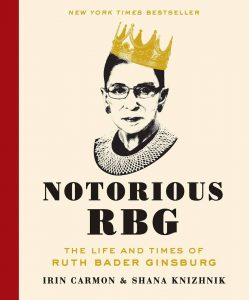Many of my friends have a great deal of affection for United States Supreme Court Justice Ruth Bader Ginsburg. My own enthusiasm for the “Notorious RBG,” however, is tempered by a consideration of the 8-1 opinion she wrote in the case of Sherrill v. Oneida Indian Nation in 2005. Today is the anniversary  of that momentous decision.
of that momentous decision.
The Oneida Indian Nation had purchased on the free market lands within the small city of Sherrill, New York, in 1997 and 1998. The lands in question were once part of the Oneidas’ 300,000 acre reservation. The State of New York had acquired the lands early in the nineteenth century in a series transactions that clearly violated the terms of the Federal Indian Trade and Intercourse Acts, which stated that purchases of Indian land without a federal commissioner present and without subsequent ratification by the Senate were null and void and of no effect.
With cash from their gaming operations, the Oneidas purchased some of these lands back. They considered the lands as part of their original reservation, and, exercising their rights as a sovereign nation, they refused to pay taxes to the City of Sherrill. The town began foreclosure proceedings against the Oneidas. The federal district court, and then the circuit court, ruled in the Oneidas’ favor. These rulings, indeed, were entirely unsurprising. But then came the Supreme Court, and the Notorious RBG.
Writing for the 8-1 majority, she shot the Oneidas down. “Given the longstanding non-Indian character of the area and its inhabitants, the regulatory authority constantly exercised by New York State and its counties and towns, and the Oneidas’ long delay in seeking judicial relief against parties other than the United States, we hold that the tribe cannot unilaterally revive its ancient sovereignty, in whole or in part, over the parcels at issue.”
Wow.
Too much time had passed since the original wrong, Ginsburg wrote. Any remedy now, after the passage of time, would be too disruptive. It would not be fair to the non-Indian land owners in the region who bought their land, she suggested, in good faith. Thus the Court must prevent “the Tribe from rekindling the embers of sovereignty that long ago grew cold.”
The Oneidas, it is true, own less than 2% of the land in the contested area and make up less than 1% of its population. Because courts were closed to the Oneidas until 1974, they could not pursue their claims against parties other than the United States. And the State of New York had exercised regulatory and legislative authority over the entire area even though its authority for doing so was murky at best. The book by the Syracuse attorney George Shattuck, who helped get the Oneidas’ land claim cases into the court system, and the Syracuse University dissertation by Philip Geier do a nice job of telling much of this story.
I have strong feelings about the Sherrill decision. We have to deal with the case. It is law, and it has had consequences. We have to confront it.
Ginsburg’s opinion was based upon a long and flawed history. Much has been made about her decision to draw upon the so-called “discovery doctrine” and Chief Justice John Marshall’s opinion in the 1823 Johnson v. McIntosh case. There is in this a legal and ideological critique of Ginsburg’s ruling that has some heft, though not as much as some people think. I would rather challenge this ruling for its willful ignorance of the region’s history. Upstate New York, and specifically the Oneidas’ aboriginal homeland, she wrote, now had few Indians who owned little land. Of course. But this was the result of a historical process through which New York became the Empire State, part of a systematic program of Iroquois dispossession. The loss of Indian lands in New York State and the advance of white settlement was not the playing out of God’s manifest destiny. It was a crime against the laws of the United States. The region lost its Native American character because of the actions of the state of New York.
Once an Indian tribe lost its lands, even if those lands were obtained illegally in a manner that violated federal law, and even when the tribe reacquired those lands from willing sellers on the open market, Ginsburg and her colleagues on the Court held that there was no longer any remedy open to the Indians. The only way to revive sovereignty over lost lands was to have Congress take those lands into trust. The very existence of the Oneida Indian Nation was not enough to do this. Tribal sovereignty, the Court implied, was a quaint and antiquated notion not worthy of its consideration. The passage of time had made history irrelevant. Let that one sink in for a minute.
And keep in mind, at issue in Sherrill was not an Indian nation’s exercise of criminal jurisdiction over non-Indians. The tribes had lost that power in 1978. Nor were we taking about the efforts of a native community to regulate or tax the activities of non-Indians on Indian lands. That, too, the Supreme Court had held was out of bounds. No. In Sherrill, the issue was whether the Oneida Indian Nation would pay taxes to the City of Sherrill on lands the Nation owned, that stood within the bounds of its historic reservation, and that they originally had lost through illegal transactions. Where is the disruption? The Oneidas were dispossessing nobody. They were imposing their authority over no one. They were merely buying back lands that had been illegally acquired from them two centuries before. And Ginsburg thought this was too disruptive. That it was not fair. The Oneidas sought not redress for waves of epidemic disease, or the military invasions of their homeland, or dispossession, or diaspora, but merely the chance to purchase the land and rebuild their nation.
Ginsburg accepted the premise that New York had acquired these lands in a manner that violated the law. She refused to allow any remedy. And with lower courts applying her ruling even more broadly to dismiss all Iroquois land claims, Ginsburg essentially validated illegal acts and excused the state’s misdeeds.
Ginsburg has written some helpful and valuable opinions in my view, but not in this case. The Supreme Court is not a promising arena for native peoples to look to for the resolution of their claims. And Sherrill, it was among the worst. It was a cowardly and cynical decision. Yeah, Justice Ginsburg seemed to say, your lands were taken from you illegally. But even if the law says those sales are of no effect, there is nothing we can do for you now. It would not be fair. Not to the white people who make up the majority of the population in the claim area. History, and the law, are written by the winners. You are out of luck.



